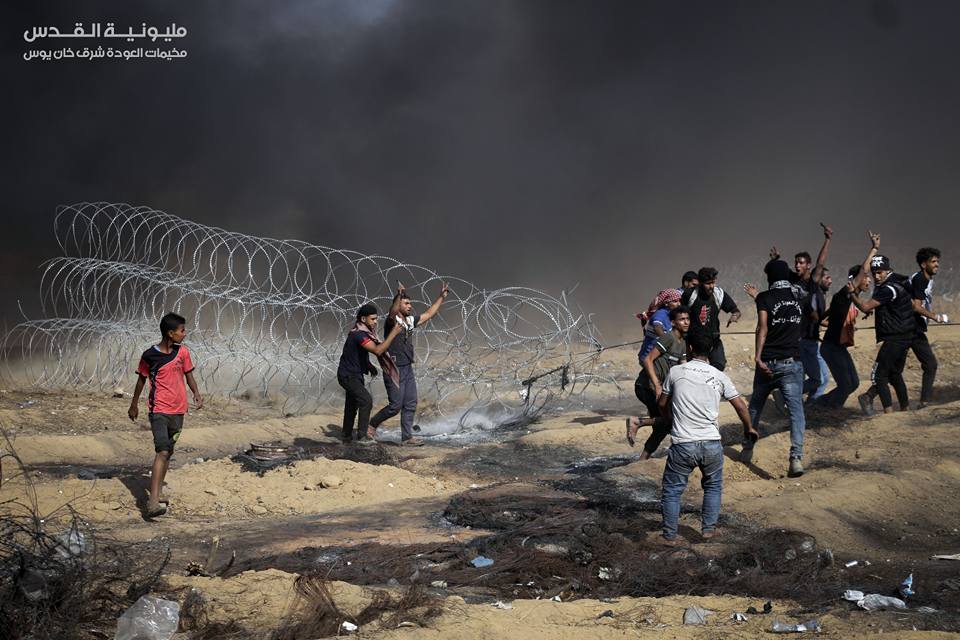Overview
The events of Friday, June 8, 2018, to mark Global Quds Day (initiated every year by Iran) and Naksa Day, continued with violence and riots encouraged by Hamas. The violence included gunfire, throwing IEDs, flying incendiary kites, and flying kites and balloons with IEDs attached to their tails. More than 10,000 Gazans participated in the Friday events, similar to the previous week, but far fewer than Hamas had expected. The demonstrators gathered at five locations along the security fence. During the riots four Gazans were killed and about 600 were wounded.[1] So far 124 Gazans have been killed in the riots, more than 80% of them terrorist operatives or affiliated with the terrorist organizations. The Friday demonstrations and riots were encouraged both practically and through propaganda by Iran. The day before, a speech was given by Ali Akbar Velayati, advisor to Ali Khamenei, supreme leader of Iran, and broadcast via video to a ceremony held in Gaza City, and Iran also gave $500 to the families of every Gazan killed in the marches.
- And what’s next? In ITIC assessment, the violence and terrorism accompanying the marches will continue in their current format. At this stage Hamas apparently does not intend to return to the status quo ante of relative quiet, which prevailed between the end of Operation Protective Edge (2014) and March 30, 2018 (the beginning of the violent marches). The Hamas leadership has made it clear that the current type of activity will continue until the “siege” on the Gaza Strip is lifted. In ITIC assessment, that means until Hamas’ demands have been met, the most meaningful one being a genuine improvement in Gaza’s economic situation.
- When the events of June 8, 2018 ended, the so-called “supreme authority of the great return march and breaking the siege” announced that the “return marches” would continue, and expressed hope that they would spill over into Jerusalem, Israel and the neighboring countries.
- The supreme authority announced Friday, June 15, 2018, when Eid al-Fitr begins, the theme will be “Friday of mercy and condolence.” The “authority’s” announcement called for holding the holiday prayer in the five “return camps” and for visits to be paid to the wounded and families of shaheeds (Ma’an and Paltoday, June 8, 2018). However, it can be assumed that the conduct of Palestinian events this coming Friday can also be expected to be violent.
Events of Friday, June 8, 2018
- The theme of the events of Friday, June 8, 2018, the tenth Friday of the “great return marches,” was “the million-man march to Jerusalem.” It marked two events: Quds Day, the last Friday of Ramadan, initiated by Iran every year since the Islamic Revolution to show support for the Palestinian struggle and the “liberation of Jerusalem;” and Naksa Day, the 51st anniversary of the defeat of the Arab states In the Six Day War (the events marking Naksa Day were moved from June 5 to coincide with Quds Day on Friday, June 8).
- The “return march” of June 8, 2018, began at around 1500 hours, when thousands of Gazans left the mosques after the Friday prayer and began gathering in the “return camps.” In ITIC assessment, there were more than 10,000 Gazans gathered at five main locations along the Gaza Strip-Israel border. The two main riots were held in the region of Jabalia in the northern Gaza Strip and Khan Yunis in the south. As they have on every Friday, rioters burned tires and threw stones. There were also several attempts to harm IDF soldiers with gunfire and by throwing hand grenades and IEDs. Some of the rioters tried to sabotage the security fence. In addition, they flew dozens of incendiary kites. There were also kites with IEDs attached to their tails. The IDF forces responded with riot control measures in accordance with IDF orders for opening fire (IDF spokesman, June 11, 2018).
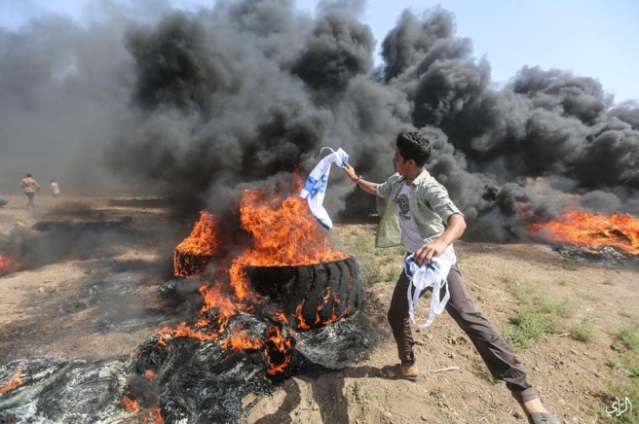

Right: Young Gazan rioters pull at a coil of barbed wire near the security fence in eastern Khan Yunis. Left: Burning the Israeli flag (Facebook page of the “supreme authority of the great return march,” June 8, 2018).
- On Saturday, June 9, 2018, fires continued burning in the western Negev, caused by incendiary kites and helium-filled balloons flown into Israeli territory from the Gaza Strip. The fires broke out in ten locations and were controlled by the Israeli fire-fighting services. No casualties were reported but there was extensive crop damage. On June 9, 2018, Israeli Air Force aircraft attacked, for the first time, a squad of terrorists in Beit Hanoun who were preparing balloons with IEDs attached to them.
The IDF response
- The IDF deployed as it has before every “great return march” Friday, and also tried to carry out a number of preventive activities. On Thursday IDF aircraft dropped notices warning residents of the Gaza Strip not to approach or damage the fence (IDF spokesman, June 7, 2018).
- On the morning of June 8, 2018, before the demonstrations and riots began, Israeli Air Force drones set fire to a pile of tires that were going to be used in the riots. The Palestinian media reported that the aircraft dropped incendiary bombs on piles of tires east of Rafah, and that Gazans were trying to extinguish the fires. Immediately afterwards, it was reported that the “tire-burning unit” in Khan Yunis had begun bringing tires to Rafah to replace those that had been destroyed (Twitter account of Shabakat Quds, June 8, 2018).
Encouraging the Palestinian public to participate in the June 8 events
- Given that the demonstrations and riots marked two important dates, the organizers, led by Hamas, tried to recruit as many participants as possible. Two days before, on Wednesday, broad recruiting efforts were made throughout the Gaza Strip. At a ceremony held on June 6, 2018, Khaled al-Batash a senior PIJ figure and head of the “supreme committee for the return marches,” called on all Gazans to participate in the Friday demonstrations and continue the struggle. Information was published about organized rides for bringing demonstrators to the various locations. In view of the efforts made beforehand to bring large numbers of people to the sites, in ITIC assessment the number of participants in the events on June 8 did not meet Hamas’ expectations.
- The Facebook page of the “great return march” posted an appeal for participants. It said the activities would be carried out in “calm gatherings” at the fence to send the Palestinian people’s message to the world. According to the appeal, activities would include cutting through the fence but not clashes with IDF soldiers (Facebook page of the “great return march,” June 8, 2018). As in the past, references to “calm demonstrations” were empty slogans, and in reality there was a high level of violence among the Palestinian rioters and the terrorist operatives who joined them.
Ceremony in Gaza City on June 7 to mark Global Quds Day
- The day before the march, Thursday, June 7, 2018, the Palestinian organizations held a ceremony In Gaza City to mark Global Quds Day and pay tribute to the families of the shaheeds killed during the “return marches.” One of the speakers (via video) was Ali Akbar Velayati, advisor to Ali Khamenei, supreme leader of Iran, who promised financial support to the families of the shaheeds. He claimed a Palestinian intifada was the only way to deal with the “dangers” facing Jerusalem. He said Jerusalem was the symbol of the Palestinians and had the ability to unite the Muslims (al-Kawthar TV, Iran, June 7, 2018).
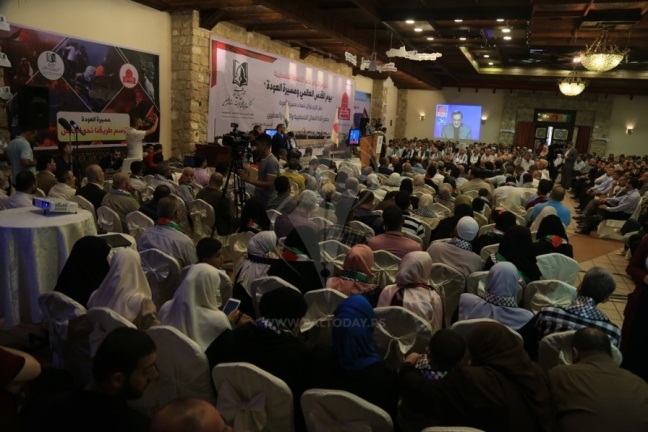
Speech given by Ali Akbar Velayati broadcast on a screen (Paltoday, June 7, 2018).
- The Arab and Iranian media reported that the families of shaheeds killed in the “return marches” in the Gaza Strip had received $500 (al-Kawthar TV in Arabic, June 7, 2018). On June 7, after the ceremony, a fast-breaking meal was held for the families of the shaheeds and each family received $500 (PalTube, June 8, 2018).
- Isma’il Haniyeh, head of Hamas’ political bureau, gave a speech in which he said that despite the Palestinians’ having sacrificed their sons in the marches, it was the most appropriate form of struggle at this time. He said the marches had led to a political and media breakthroughin everything relating to the struggle against Israel, the liberation of Palestine and recognition of the “right of return.” They proved, he claimed, that despite the “siege,” the Palestinian people had the ability to take the initiative, make breakthroughs and put the Palestinian cause at the head of the public agenda. As to the rocket and mortar shell fire, he claimed the most recent round of fighting had emphasized the unity of all the methods of “resistance:” “popular,” military, and political-media (al-Aqsa, June 7, 2018).
Use of incendiary kites on June 8, 2018
- On June 8, 2018, the use of incendiary kites increased. The kites flown into Israeli territory caused about 40 fires. Hamas and the other terrorist organizations are fully aware of the economic and moral damage to Israel and its image resulting from the kites. That led them to fly kites and helium-filled balloons with IEDs attached to their tails, in addition to the incendiary kites. Residents of the Israeli communities near the Gaza Strip were warned not to approach the kites or touch them. The operatives flying the kites call themselves the “al-Zoari units,” or the “sons of al-Zoari units,” after the Tunisian aeronautics engineer Muhammad al-Zoari, who worked for Hamas and was killed in Tunisia.[2]
![Frames for incendiary kites and signs ready for flying into Israel. The sign at the right reads, "You are within range of the kites of the sons of [Muhammad] al-Zoari: Be'eri, Re'im and Kissufim [names of Israeli communities]. Signed, the sons of [Muhammad] al-Zoari, central Gaza Strip" (Facebook page of Iyad Muhammad al-Baz Abu Musheir, operative in the Gaza Strip military police, June 8, 2018). Frames for incendiary kites and signs ready for flying into Israel. The sign at the right reads, "You are within range of the kites of the sons of [Muhammad] al-Zoari: Be'eri, Re'im and Kissufim [names of Israeli communities]. Signed, the sons of [Muhammad] al-Zoari, central Gaza Strip" (Facebook page of Iyad Muhammad al-Baz Abu Musheir, operative in the Gaza Strip military police, June 8, 2018).](http://israelbehindthenews.com/wp-content/uploads/2018/06/word-image-1528834808113.jpeg)
![Frames for incendiary kites and signs ready for flying into Israel. The sign at the right reads, "You are within range of the kites of the sons of [Muhammad] al-Zoari: Be'eri, Re'im and Kissufim [names of Israeli communities]. Signed, the sons of [Muhammad] al-Zoari, central Gaza Strip" (Facebook page of Iyad Muhammad al-Baz Abu Musheir, operative in the Gaza Strip military police, June 8, 2018). Frames for incendiary kites and signs ready for flying into Israel. The sign at the right reads, "You are within range of the kites of the sons of [Muhammad] al-Zoari: Be'eri, Re'im and Kissufim [names of Israeli communities]. Signed, the sons of [Muhammad] al-Zoari, central Gaza Strip" (Facebook page of Iyad Muhammad al-Baz Abu Musheir, operative in the Gaza Strip military police, June 8, 2018).](http://israelbehindthenews.com/wp-content/uploads/2018/06/word-image-1528834809639.jpeg)
Frames for incendiary kites and signs ready for flying into Israel. The sign at the right reads, “You are within range of the kites of the sons of [Muhammad] al-Zoari: Be’eri, Re’im and Kissufim [names of Israeli communities]. Signed, the sons of [Muhammad] al-Zoari, central Gaza Strip” (Facebook page of Iyad Muhammad al-Baz Abu Musheir, operative in the Gaza Strip military police, June 8, 2018).
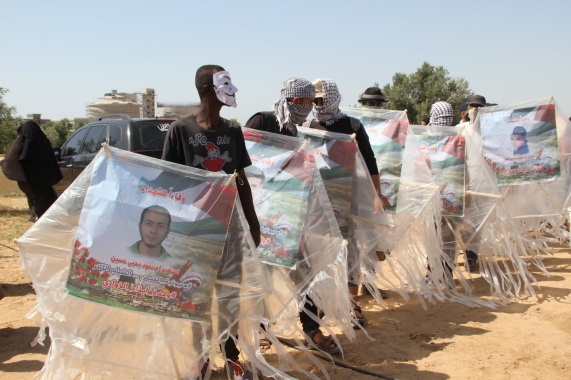
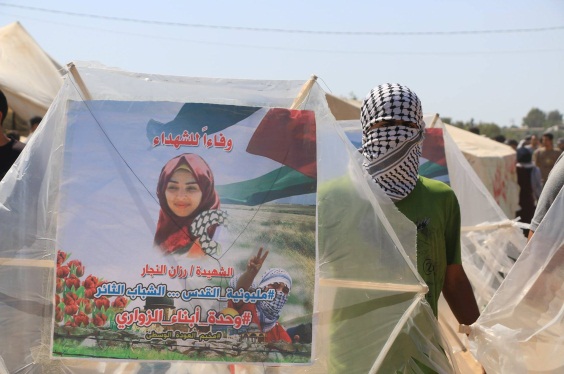
Kites with pictures of shaheeds. Right: Razan al-Najar (Facebook page of the “supreme authority of the great return march,” June 8, 2018).
Terrorist attacks carried out under cover of demonstrations and riots
During the riots a number of attacks on IDF forces were attempted. The IDF reported that shots were fired an IDF posts in the northern Gaza Strip. No casualties were reported. A hand grenade and pipe bomb were thrown. In addition, a kite was flown which apparently had explosives attached to it. It exploded in the air (IDF spokesman, June 8, 2018).
Senior Hamas figures encourage participation in “return march” events
- On June 8 senior Hamas figures were present on the ground and encouraged the masses to continue the marches. Among them were Isma’il Haniyeh, head of Hamas’ political bureau, who attended the riots in eastern Gaza City (Dunia al-Watan, June 8, 2018) as did Fathi Hamad and Khalil al-Haya, both members of Hamas’ political bureau, and others. All those who spoke stressed that the Palestinian people would continue the jihad, the “resistance” and “continue the peaceful marches until the end of the ‘occupation’ “ (al-Quds, June 8, 2018).
- Ahmed Bahar, deputy chairman of the Palestinian Legislative Council, said the “peaceful” marches, during which young Gazans have been killed by “Zionist enemy fire,” proved the “resistance” was not inactive. The Palestinians, he said, had broken the equation Israel was trying to force on them, and had created a new equation through the marches. He claimed the greatest achievement for the Palestinian people was that the Palestinian cause was now an accepted media and political priority (Shehab, June 8, 2018).
Participation of children in demonstrations and riots
- As usual, this past Friday there was extensive participation of children and adolescents in the riots. Some of them were even on the front lines in the clashes with the IDF. Among those killed was a 15-year-old who was affiliated with Hamas (his body was wrapped in a Hamas flag for burial).
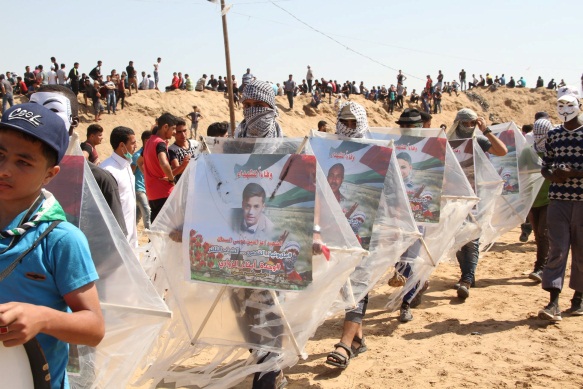
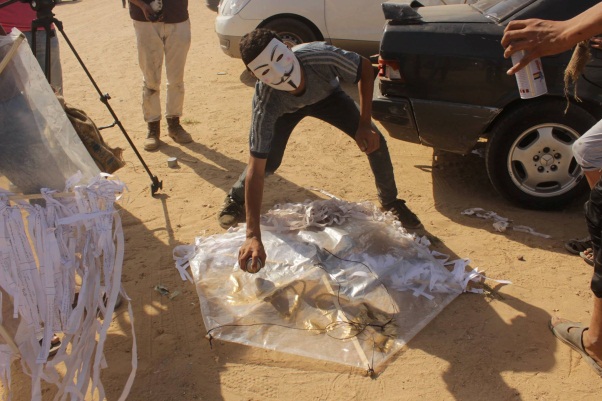 |
|
Children carry kites with pictures of shaheeds (Facebook page of the “supreme authority of the great return march,” June 8, 2018).
Appendix
Distribution of organizational affiliation of Gazans killed in the “great return march”[3] (updated)
- During the June 8, 2018 “return march,” four people were killed. Two of them, including a 15-year-old boy, were affiliated with Hamas. The organizational identity of the other two is not known by the ITIC.
- According to the Hamas-controlled ministry of health in the Gaza Strip, so far 127 people have been killed in the “return marches” since March 30 (Facebook page of the spokesman of the ministry of health in the Gaza Strip, June 8, 2018). The ITIC has found and examined 124 names.
- Of the 124 of Gazans killed, 102 belonged to terrorist organizations or were affiliated with the terrorist organizations (more than 80%). Of them, 69 were Hamas terrorist operatives or affiliated with Hamas (about 67% of the terrorist operatives or those affiliated with terrorist organizations killed in the “return marches”). Three were terrorist operatives but their organizational affiliation is unclear because Hamas and other terrorist organizations claimed them (for the statistical purposes of this report they were assigned to Hamas). The identity of 22 of those killed is still unknown. It can be assumed that most of them were civilians.
Affiliation of Gazan Terrorists Killed in the “Great Return March”
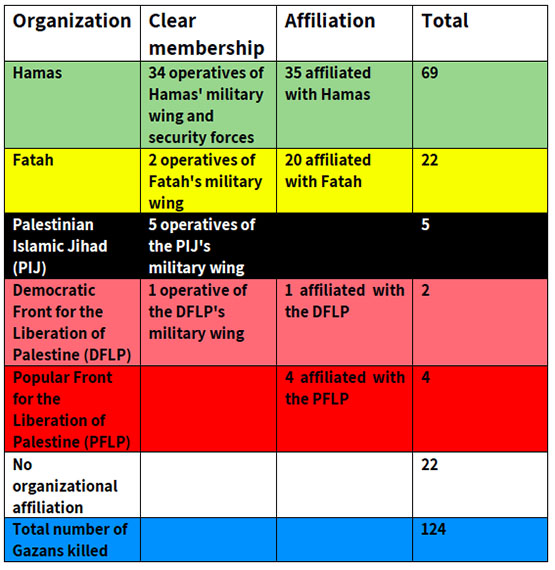
[1] Two affiliated with Hamas and two of unknown affiliation. ↑
[2] On December 15, 2016, the killing of Muhammad al-Zoari in a drive-by shooting was reported. He was 49 years old, an engineer, and came from a religious family in Sfax, eastern Tunisia. After he finished his studies and served in the army, he earned a civilian pilot’s license and was employed as a pilot by Tunisair. He was fired because of his activity in the Tunisian Islamist al-Nahda party and fled to Sudan. In 1991 he went to Syria and joined Hamas military-terrorist wing, where he developed unmanned aerial vehicles and hang-gliders for Hamas. ↑
[3] For further information about the identities of Gazans killed in the “great return march,” see the May 25, 2018 bulletin “Findings of the ITIC’s examination of the identity of Palestinians killed in the events of the “Great Return March” (March 30, 2018 – May 15, 2018).” ↑





